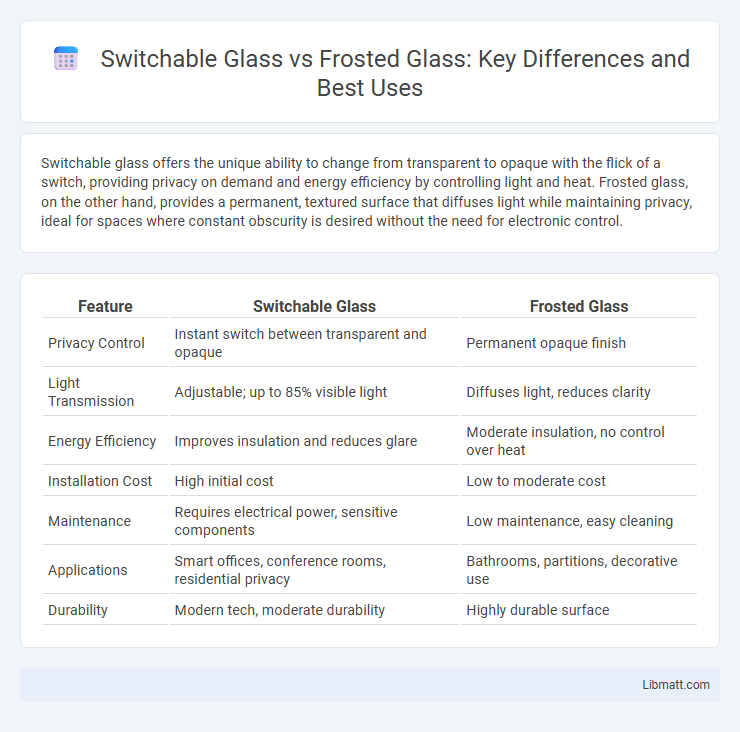Switchable glass offers the unique ability to change from transparent to opaque with the flick of a switch, providing privacy on demand and energy efficiency by controlling light and heat. Frosted glass, on the other hand, provides a permanent, textured surface that diffuses light while maintaining privacy, ideal for spaces where constant obscurity is desired without the need for electronic control.
Table of Comparison
| Feature | Switchable Glass | Frosted Glass |
|---|---|---|
| Privacy Control | Instant switch between transparent and opaque | Permanent opaque finish |
| Light Transmission | Adjustable; up to 85% visible light | Diffuses light, reduces clarity |
| Energy Efficiency | Improves insulation and reduces glare | Moderate insulation, no control over heat |
| Installation Cost | High initial cost | Low to moderate cost |
| Maintenance | Requires electrical power, sensitive components | Low maintenance, easy cleaning |
| Applications | Smart offices, conference rooms, residential privacy | Bathrooms, partitions, decorative use |
| Durability | Modern tech, moderate durability | Highly durable surface |
Introduction to Switchable and Frosted Glass
Switchable glass, also known as smart glass, uses liquid crystal technology to change from transparent to opaque with an electrical signal, offering privacy on demand. Frosted glass is created by sandblasting or acid etching clear glass to produce a permanent translucent surface that diffuses light and obscures vision. Both types provide privacy solutions but differ in functionality, with switchable glass allowing dynamic control and frosted glass offering constant obscurity.
How Switchable Glass Works
Switchable glass uses a thin layer of liquid crystals or suspended particles sealed between two glass panels, which change alignment when an electric current passes through, transitioning from opaque to transparent instantly. Unlike frosted glass that relies on permanent etched or sandblasted textures to scatter light, switchable glass offers dynamic control over privacy and light transmission. You can easily adjust the transparency of switchable glass to suit different environments without sacrificing natural light or design aesthetics.
Understanding Frosted Glass
Frosted glass features a textured, translucent surface created through sandblasting or acid etching, providing privacy while allowing diffused light to pass through. Unlike switchable glass, which changes opacity electronically, frosted glass maintains a permanent frosted appearance without electrical components. Its static nature makes it ideal for consistent privacy needs in office partitions, bathroom windows, and decorative panels.
Privacy Control: Switchable vs Frosted Glass
Switchable glass offers dynamic privacy control by instantly changing from transparent to opaque with the flip of a switch, providing on-demand privacy in offices, homes, and commercial spaces. Frosted glass provides permanent privacy through a textured or sandblasted surface that diffuses light but lacks flexibility to revert to transparency. The key advantage of switchable glass lies in its versatility and energy efficiency, while frosted glass ensures consistent privacy without the need for electrical power.
Aesthetic Differences and Design Flexibility
Switchable glass offers dynamic opacity control that transforms your space instantly, creating modern, sleek designs with the ability to switch between transparent and opaque states. Frosted glass provides a consistent matte finish that delivers a timeless, elegant aesthetic suitable for privacy without altering light transmission. The design flexibility of switchable glass enables innovative architectural solutions, while frosted glass remains a classic choice for subtle diffusion and decorative patterns.
Energy Efficiency and Light Control
Switchable glass offers advanced energy efficiency by dynamically adjusting opacity to reduce heat gain and loss, lowering HVAC costs and enhancing indoor comfort. Frosted glass provides consistent light diffusion but lacks the ability to modulate natural light or thermal transfer, resulting in less control over energy consumption. Switchable glass technology enables precise light control and improved insulation, making it a superior choice for sustainable building design compared to traditional frosted glass.
Installation and Maintenance Comparison
Switchable glass requires professional installation due to its electrical components and wiring, which can increase upfront labor costs compared to frosted glass, typically easier to install with standard glazing techniques. Maintenance for switchable glass involves ensuring the electrical system remains functional and occasional cleaning with non-abrasive materials, while frosted glass demands minimal upkeep, mainly surface cleaning to retain its matte appearance. Your choice between these two should consider the complexity of installation and ongoing maintenance needs aligned with your project's technical capabilities and aesthetic preferences.
Cost Analysis: Initial and Long-Term
Switchable glass typically requires a higher initial investment, ranging from $80 to $120 per square foot, compared to frosted glass, which averages $20 to $50 per square foot. Over the long term, switchable glass can offer energy savings due to its ability to control light and heat transmission, potentially reducing HVAC costs, while frosted glass lacks such adaptive features. Maintenance costs for switchable glass are generally higher due to the electronic components involved, whereas frosted glass requires minimal upkeep.
Common Applications for Each Glass Type
Switchable glass is commonly used in conference rooms, hospitals, and privacy-sensitive areas where instant control of transparency is essential for security and light management. Frosted glass is frequently found in bathrooms, office partitions, and decorative windows, providing permanent privacy while allowing natural light to pass through. Your choice depends on whether you need dynamic control of visibility or consistent opacity for privacy.
Choosing the Right Glass for Your Space
Switchable glass offers dynamic control over privacy and light transmission, making it ideal for modern offices and smart homes where adaptability is key. Frosted glass provides consistent diffusion of light and privacy, perfect for bathrooms, conference rooms, and decorative elements needing a permanent opaque solution. Assessing specific needs for light control, privacy, and design flexibility helps in choosing between the innovative switchable glass and the classic frosted glass for your space.
Switchable glass vs frosted glass Infographic

 libmatt.com
libmatt.com